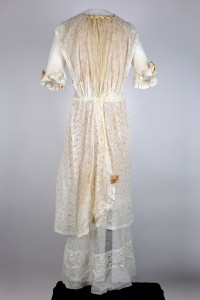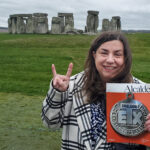Remembering Life and Death on the Border

Two Texas Rangers sit on their horses and proudly pose for a photo in 1915. Attached to the ends of their ropes, dragging on the ground, are four dead Mexican-American “bandits” who had just been killed by U.S. soldiers in a raid on King Ranch. When all was said and done, the Texas Rangers had come in and set up the image to convey a single message—they were in charge.
The violent scene had become the era’s new normal. People living on the border between Texas and Mexico could walk into a general store, grab the photo-turned-postcard, write a message, and send it off to their families. Now, the postcard has been blown up into a large print and stands as part of the “Life and Death on the Border 1910-1920” exhibit at the Bullock Texas State History Museum. Now, though, the dead men are cropped out.
“Not only were Texas-Mexicans victimized through direct violence, they were victimized through representational violence,” John Morán González says as we walk through the museum. “We did not want to re-victimize them. We just wanted to tell people this became normalized in everyday life.”
The exhibit, which runs through April 3, was a collaboration between professors from all over the nation, including González, who is an associate professor of English at UT. They approached the museum’s staff with their idea roughly two years ago and have since made it their mission to document and showcase the state-sanctioned violence that occurred along the border during the early 20th century. It’s a story that participating historian and Brown University professor Monica Muñoz Martinez says is not often told.
“There’s been a dominant narrative of Texas history that has either ignored the violence in this period or justified it by saying the killings were to get rid of revolutionaries who were threatening civility and peace,” she says. “This is the first time that a state museum is acknowledging the violence and acknowledging the role of state agents and administrators.”
 When visitors arrive to the exhibit, they are greeted by a large photo of 1916 Brownsville, the border town where González was raised. “Part of all this was realizing I grew up not knowing this history even though it happened right there,” he says.
When visitors arrive to the exhibit, they are greeted by a large photo of 1916 Brownsville, the border town where González was raised. “Part of all this was realizing I grew up not knowing this history even though it happened right there,” he says.
To the left is a glass case containing wedding gowns and other bridal items from the period. On the walls are portraits of Texas-Mexican families, alongside a large quilt, homemade altar pieces, and ranch tools. “We wanted to give a sense of the way of life that existed in the borderlands,” González says.
The team of professors—which also includes Sonia Hernandez from Texas A&M University, Trinidad Gonzáles from South Texas College, and Benjamin Johnson from Loyola University Chicago—gathered much of their information and artifacts while working on another project, called Refusing to Forget, which also aims to memorialize the era’s history. Muñoz Martinez says their work could have never been done without the help of families along the border like Evaristo “Buddy” and Benita Albarado from Uvalde, who have spent years recording their ancestors’ losses.
“[The exhibit] has been so satisfying for them,” Muñoz Martinez says. “It doesn’t bring closure for the acts of violence that their families experienced but, finally, to have it acknowledged is a real move forward.”
Next in the exhibit is a map of Texas that explains the border’s development. González stresses that people living in the region at the turn of the century considered themselves to be more a part of Mexico than America. A majority were war refugees, fleeing the reign of Porfirio Diaz in Mexico.
It wasn’t until 1904 that Anglos started moving in, when railroads connecting the Rio Grande Valley to the Midwest were created and irrigation systems came into play. “So now you have this rapid turnover of land and economics as they come in for cheap land and cheap labor,” González says.

As Anglo farmers took over the lands, Tejano ranchers grew increasingly upset. The newcomers, accustomed to Jim Crow Laws further north, brought in racial hierarchies, implementing whites-only primaries, poll taxes, and English literacy tests. In the spirit of the campesinos— or poor farmers—who had began the Mexican Revolution in 1910, the ranchers formed their own uprising, destroying automobiles, derailing a train, and sometimes killing Anglo landowners.
A saddle that belonged to Pancho Villa and revolutionary Victoriano Huerta’s rifle rest in one of the cases, commemorating the Tejanos that became known as los sediciosos, the seditious ones. That’s where the Texas Rangers come in. Originally, they were commissioned to restore peace and keep los sediciosos in line. But, knowing there was little consequence, the Rangers killed hundreds of people, who were oftentimes innocent. One of the worst incidents was the Porvenir Massacre of 1918, in which the Rangers took 15 men and boys whom they accused of participating in a ranch raid and shot them outside their village. And all the while, tensions from World War I loomed over the borderlands .
The last part of the exhibit focuses on the aftermath of the Tejanos’ uprisings. González says Texas-Mexican intellectuals began to think about how they could preserve their rights when neither Mexico or America felt the need to protect them. These issues gave way to civil rights organizations like LULAC, or the League of United Latin American Cultures, Chicano culture, and the popularity of the term Mexican-American. Surrounded by slightly more modern artifacts, like 1950s literature and Raza Unida buttons from the ’70s, I ask González how the museum’s exhibits are relevant today.
“Democracy has always been beset around issues of racialization,” he says. “In order to successfully navigate the next step, issues of justice from the past need to be addressed. Policy brutality, authority issues—those are contemporary issues that are still right in front of us.” 
At the start of our tour, two men visiting the exhibit had approached us. “You must be Dr. González,” one of them says, reaching out to take his hand. “I’m familiar with what you’re doing and we’re so proud of you.” He says his name is Juan Castro, and they’re visiting from the Valley. He and his friend, Ray Garza, go on to say they can’t believe they grew up never knowing their own history.
“What you’re doing is so important,” Castro says to González. “It’s amazing that in 2016 we’re able to relive this again because it needs to come out.”
Once “Life and Death on the Border” closes in April, the team and the museum hope to turn it into a traveling exhibit, visiting cities around the country. Through Refusing to Forget, the historians have also been working toward getting numerous historical markers on places related to the era, and plan to unveil at least four in the spring.
“Books and articles have done little to create a lasting dialogue or shift public perception,” Muñoz Martinez says. “But by moving beyond academic arenas and working with cultural institutions, we can make this part of public history.”
Photo credits from top: Robert Runyon Photograph Collection; Robert Runyon Photograph Collection; Russell Lee Photography Collection; Museum of South Texas History; Raza Unida Party Records

















No comments
Be the first one to leave a comment.